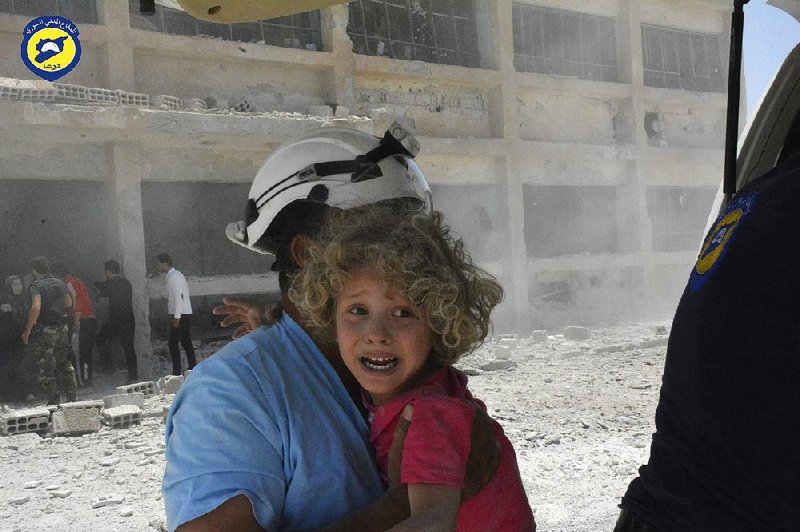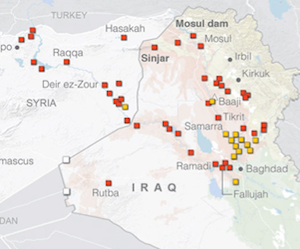BEIRUT -- A U.N. investigative commission for Syria said Wednesday that last month's "de-escalation" agreement has reduced violence in only one of the four zones included in the deal and has not led to greater humanitarian access to besieged areas across the war-torn country.
RELATED ARTICLE
http://www.arkansas…">Tora Bora in hands of ISIS
Underscoring the ongoing violence, a barrage of airstrikes and artillery shells pummeled different areas of southern Daraa province Wednesday, leaving at least eight people dead, including children, first responders and activists said.
A western diplomat said the U.S., Russia and Jordan were holding private meetings in Amman to halt the fighting between rebels and the government in southern Syria.
The three states are debating the boundaries of a cease-fire line between the government and rebels in what is hoped to be a comprehensive agreement that would delineate the control of border crossings with Jordan, the diplomat said, speaking on condition of anonymity because he was not authorized to brief the media.
In Geneva, the Independent International Commission of Inquiry told the U.N. Human Rights Council that fighting around the central province of Homs, near Damascus and in the southern city of Daraa has continued -- despite the deal brokered by Russia, Turkey and Iran in May.
Only in the northern Idlib province and western Aleppo has there been "discernible reduction" in violence, said the chairman of the U.N. commission, Paulo Sergio Pinheiro.
Violence in Daraa has escalated, with some of the most intense bombing reported in recent weeks.
On Wednesday, activists and rescue workers reported at least 12 airstrikes and artillery shelling in different areas of Daraa, the southern province divided between insurgents and government forces. Syrian Civil Defense first responders, also known as White Helmets, reported airstrikes on a school that served as a shelter for displaced people in Tafs, in the province' west.
Initial reports said at least eight people from the same family were killed, according to the first responders who said the displaced had gathered at the site of the aftermath of an earlier strike nearby.
The Syrian Observatory for Human Rights put the death toll at nine. A video from first responders distributed on social media shows bodies strewn on the floor as rescuers search for survivors, lifting children out of the rubble amid wails from women.
"Whether it be the unrestrained use of airstrikes against residential neighborhoods, attacks against doctors and hospitals, or the use of suicide bombers that deliberately target civilians, fighting remains brutal in purpose and reprehensible in method," Pinheiro said.
A map of the de-escalation zones and a mechanism of how to monitor them have yet to be released. Pinheiro said there has also not been any improvement in the delivery of humanitarian aid.
"In those areas more urgently in need of humanitarian assistance, the United Nations has only been permitted one humanitarian delivery in 2017," he told the council. "Time and time again, warring parties and influential states have failed to capitalize on the opportunities presented by the respites from hostilities."
Outside the four zones, Pinheiro said some 600,000 people remain trapped in besieged areas where many are subjected to daily airstrikes.
The U.N. report came as the U.S. deployed a truck-mounted missile system into Syria to a group of rebels and U.S. military advisers that have repeatedly clashed with government forces, an official said Wednesday.
The deployment was in eastern Syria, where Iranian-sponsored pro-government forces have outflanked U.S. advisers and rebels holding the Tanf border crossing to establish their own link to Iraq for the first time in years.
Shifting the missile system into eastern Syria from Jordan will give the U.S. a precise, long-range weapon to protect its advisers and allies in Tanf, and to attack Islamic State militants farther downfield. It has a range of 186 miles.
The Pentagon official requested anonymity, to discuss unannounced military movements.
U.S.-backed rebels were advancing north along the Syrian-Iraqi frontier, against Islamic State militants, when pro-government forces cut them off with a flanking maneuver last week.
U.S. special forces operators are embedded with the rebels in an advisory capacity, the Pentagon says, though they have fought alongside their allies in defense battles. They hold two outposts in the desert region.
The U.S. central military command has said it remains committed to reaching and defeating the Islamic State in its strongholds along the Euphrates, beginning with Boukamal, 137 miles northeast of Tanf.
A Section on 06/15/2017

